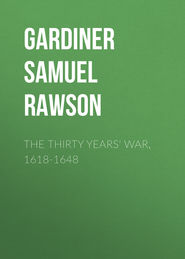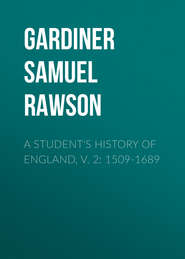По всем вопросам обращайтесь на: info@litportal.ru
(©) 2003-2024.
✖
What Gunpowder Plot Was
Настройки чтения
Размер шрифта
Высота строк
Поля
121
Mrs. Everett Green’s abstract of this, to the effect that Fawkes said that the conspiracy ‘was confined to five persons at first, then to two, and afterwards five more were added,’ has no foundation in the document she had before her.
122
G. P. B. No. 49.
123
G. P. B. No. 37.
124
G. P. B. No. 133.
125
The name ‘Key’ or ‘Keyes’ occurs in both of them without his Christian name.
126
Proclamation Book, R.O.
127
G. P. B. No. 129.
128
‘The Discourse of the Powder Treason,’ published in Bishop Montague’s Works of James I., p. 233, only forms part of the original so-called ‘King’s Book,’ which was published anonymously in 1605 (i. e., before March 25, 1606) under the title of His Majesty’s Speech in this last Session of Parliament … together with a Discourse of the Manner of the Discovery of this late Intended Treason, joined with the Examination of Some of the Prisoners. – Brit. Mus., Press Mark E. 1940, No. 10. In the Preface directed by the Printer to the Reader, the Printer states that he was about to commit the Speech to the press when there came into his hands ‘a discourse of this late intended most abominable treason,’ which he has added. The King’s speech was delivered on November 9, and, if it was to be published, it is not likely to have been long kept back. The discourse consists of four parts – 1. An account of the discovery of the plot, and arrest of Fawkes. 2. Fawkes’s declaration of the 17th. 3. Winter’s confession of the 23rd. 4. An account of the flight and capture of the conspirators. The whole composition shows signs of an early date. Part 1 knows nothing of any names except those of Percy and Johnson alias Fawkes, and was probably, therefore, drawn up before the confession of the 9th. At the end it slips off from a statement that Fawkes, having been ‘twice or thrice examined when the rack having been only offered and showed unto him, the mask of his Roman fortitude did visibly begin to wear and slide off his face, and then did he begin to confess part of the truth,’ into ‘and thereafter to open up the whole matter as doth appear by his depositions immediately following.’ Then comes the declaration of November 17, with Winter amongst the diggers and Keyes amongst those afterwards made privy. Between Parts 2 and 3 we have the following statement: “And in regard that before this discovery could be ready to go to the press, Thomas Winter, being apprehended and brought to the Tower, made a confession in substance agreeing with this former of Fawkes’s, only larger in some circumstances. I have thought good to insert the same likewise in this place, for the further clearing of the matter and greater benefit of the reader.” May we not gather from this that the ‘discourse’ was finally made up for the press on or very soon after the 23rd? Winter, it may be noted, does not mention the name either of his brother or of Keyes.
129
Gerard, App. E., p. 251.
130
This note is on too small a scale to be reproduced in the frontispiece.
131
This name is given at a later time to the ‘Passage leading to the Parliament Stairs’ of Capon’s plan, and I have, for convenience sake, referred to it throughout by that name.
132
See p. 22.
133
Gerard, p. 62.
134
Gerard, pp. 141, 142.
135
I suppose Thomas Barlow is meant. William Barlow, who was Bishop of Lincoln in the reign of James I., did not write about the plot.
136
Speed’s History, ed. 1611, p. 891.
137
March 24th, 1604.
138
Copy of the Agreement, G. P. B., No. 1.
139
Pat. 44 Eliz., Part 22.
140
Gerard, p. 60, note 1.
141
Smith’s Antiquities of Westminster, p. 39. The question of the number of doors in the cellar will be dealt with hereafter.
142
Gerard, p. 67.
143
Gerard, p. 65.
144
P. 56.
145
Pat. 4 Edw. VI., Part 9.
Mrs. Everett Green’s abstract of this, to the effect that Fawkes said that the conspiracy ‘was confined to five persons at first, then to two, and afterwards five more were added,’ has no foundation in the document she had before her.
122
G. P. B. No. 49.
123
G. P. B. No. 37.
124
G. P. B. No. 133.
125
The name ‘Key’ or ‘Keyes’ occurs in both of them without his Christian name.
126
Proclamation Book, R.O.
127
G. P. B. No. 129.
128
‘The Discourse of the Powder Treason,’ published in Bishop Montague’s Works of James I., p. 233, only forms part of the original so-called ‘King’s Book,’ which was published anonymously in 1605 (i. e., before March 25, 1606) under the title of His Majesty’s Speech in this last Session of Parliament … together with a Discourse of the Manner of the Discovery of this late Intended Treason, joined with the Examination of Some of the Prisoners. – Brit. Mus., Press Mark E. 1940, No. 10. In the Preface directed by the Printer to the Reader, the Printer states that he was about to commit the Speech to the press when there came into his hands ‘a discourse of this late intended most abominable treason,’ which he has added. The King’s speech was delivered on November 9, and, if it was to be published, it is not likely to have been long kept back. The discourse consists of four parts – 1. An account of the discovery of the plot, and arrest of Fawkes. 2. Fawkes’s declaration of the 17th. 3. Winter’s confession of the 23rd. 4. An account of the flight and capture of the conspirators. The whole composition shows signs of an early date. Part 1 knows nothing of any names except those of Percy and Johnson alias Fawkes, and was probably, therefore, drawn up before the confession of the 9th. At the end it slips off from a statement that Fawkes, having been ‘twice or thrice examined when the rack having been only offered and showed unto him, the mask of his Roman fortitude did visibly begin to wear and slide off his face, and then did he begin to confess part of the truth,’ into ‘and thereafter to open up the whole matter as doth appear by his depositions immediately following.’ Then comes the declaration of November 17, with Winter amongst the diggers and Keyes amongst those afterwards made privy. Between Parts 2 and 3 we have the following statement: “And in regard that before this discovery could be ready to go to the press, Thomas Winter, being apprehended and brought to the Tower, made a confession in substance agreeing with this former of Fawkes’s, only larger in some circumstances. I have thought good to insert the same likewise in this place, for the further clearing of the matter and greater benefit of the reader.” May we not gather from this that the ‘discourse’ was finally made up for the press on or very soon after the 23rd? Winter, it may be noted, does not mention the name either of his brother or of Keyes.
129
Gerard, App. E., p. 251.
130
This note is on too small a scale to be reproduced in the frontispiece.
131
This name is given at a later time to the ‘Passage leading to the Parliament Stairs’ of Capon’s plan, and I have, for convenience sake, referred to it throughout by that name.
132
See p. 22.
133
Gerard, p. 62.
134
Gerard, pp. 141, 142.
135
I suppose Thomas Barlow is meant. William Barlow, who was Bishop of Lincoln in the reign of James I., did not write about the plot.
136
Speed’s History, ed. 1611, p. 891.
137
March 24th, 1604.
138
Copy of the Agreement, G. P. B., No. 1.
139
Pat. 44 Eliz., Part 22.
140
Gerard, p. 60, note 1.
141
Smith’s Antiquities of Westminster, p. 39. The question of the number of doors in the cellar will be dealt with hereafter.
142
Gerard, p. 67.
143
Gerard, p. 65.
144
P. 56.
145
Pat. 4 Edw. VI., Part 9.









